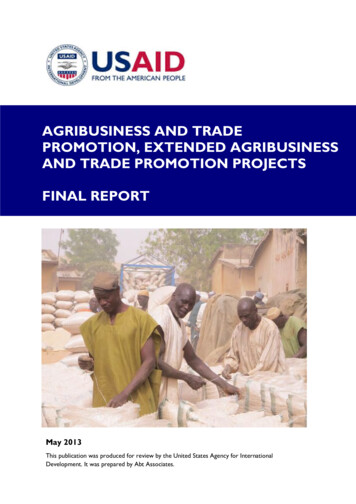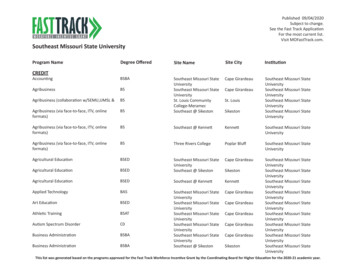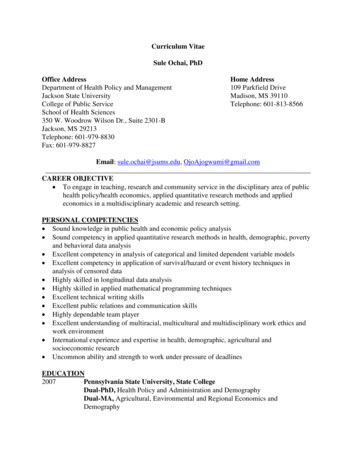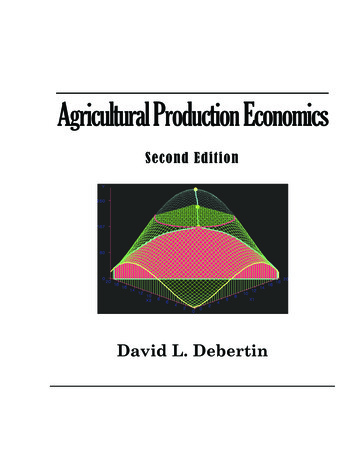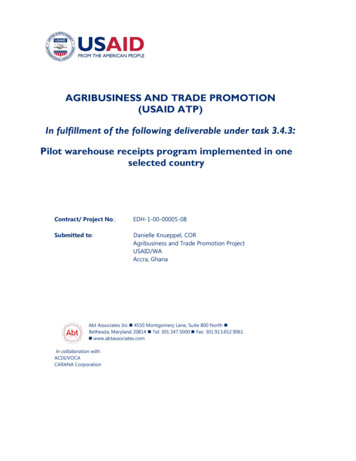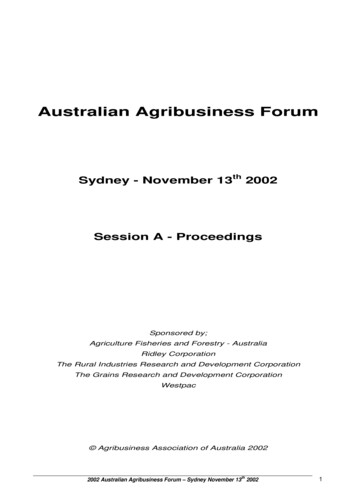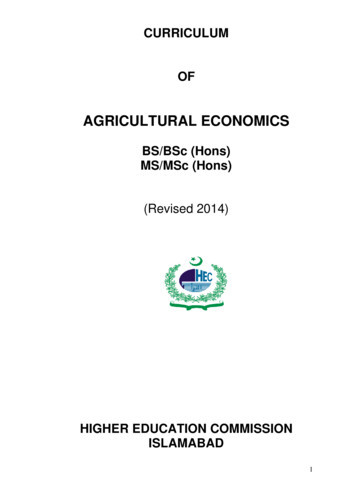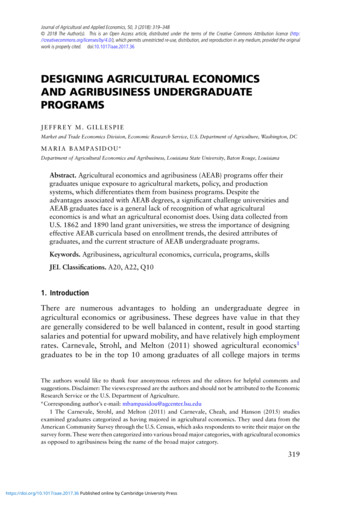
Transcription
Journal of Agricultural and Applied Economics, 50, 3 (2018): 319–348 2018 The Author(s). This is an Open Access article, distributed under the terms of the Creative Commons Attribution licence (http://creativecommons.org/licenses/by/4.0/), which permits unrestricted re-use, distribution, and reproduction in any medium, provided the originalwork is properly cited. doi:10.1017/aae.2017.36DESIGNING AGRICULTURAL ECONOMICSAND AGRIBUSINESS UNDERGRADUATEPROGRAMSJEFFREY M. GILLESPIEMarket and Trade Economics Division, Economic Research Service, U.S. Department of Agriculture, Washington, DCM A R I A B A M PA S I D O U Department of Agricultural Economics and Agribusiness, Louisiana State University, Baton Rouge, LouisianaAbstract. Agricultural economics and agribusiness (AEAB) programs offer theirgraduates unique exposure to agricultural markets, policy, and productionsystems, which differentiates them from business programs. Despite theadvantages associated with AEAB degrees, a significant challenge universities andAEAB graduates face is a general lack of recognition of what agriculturaleconomics is and what an agricultural economist does. Using data collected fromU.S. 1862 and 1890 land grant universities, we stress the importance of designingeffective AEAB curricula based on enrollment trends, the desired attributes ofgraduates, and the current structure of AEAB undergraduate programs.Keywords. Agribusiness, agricultural economics, curricula, programs, skillsJEL Classifications. A20, A22, Q101. IntroductionThere are numerous advantages to holding an undergraduate degree inagricultural economics or agribusiness. These degrees have value in that theyare generally considered to be well balanced in content, result in good startingsalaries and potential for upward mobility, and have relatively high employmentrates. Carnevale, Strohl, and Melton (2011) showed agricultural economics1graduates to be in the top 10 among graduates of all college majors in termsThe authors would like to thank four anonymous referees and the editors for helpful comments andsuggestions. Disclaimer: The views expressed are the authors and should not be attributed to the EconomicResearch Service or the U.S. Department of Agriculture. Corresponding author’s e-mail: mbampasidou@agcenter.lsu.edu1 The Carnevale, Strohl, and Melton (2011) and Carnevale, Cheah, and Hanson (2015) studiesexamined graduates categorized as having majored in agricultural economics. They used data from theAmerican Community Survey through the U.S. Census, which asks respondents to write their major on thesurvey form. These were then categorized into various broad major categories, with agricultural economicsas opposed to agribusiness being the name of the broad major category.319https://doi.org/10.1017/aae.2017.36 Published online by Cambridge University Press
320J E F F R E Y M . G I L L E S P I E A N D M A R I A B A M PA S I D O Uof full-time employment in 2009. At that time, median earnings of agriculturaleconomics graduates were 60,000, with food science being the only majortraditionally offered by colleges of agriculture with a higher median income.An updated analysis by Carnevale, Cheah, and Hanson (2015) showed medianagricultural economics graduate earnings of 67,000, which was highest amongagriculture majors with 25% of those holding the degree earning in excessof 100,000/year. Agricultural economics graduates had higher earnings thangeneral business graduates, with some of the specific fields within businesshaving higher and others having lower earnings. The attribute of agriculturaleconomics and agribusiness (AEAB) graduates that has generally been argued todifferentiate them from general business graduates is their expertise in the uniqueaspects of the agricultural industry.Despite the advantages associated with AEAB degrees, a significant challengeuniversities and AEAB graduates face is a general lack of public recognitionof what agricultural economics is and what an agricultural economist does.With smaller percentages of the general population hailing from farms andrural areas, fewer people are likely to be well versed in agriculture (Colbathand Morrish, 2010; Dale, Robinson, and Edwards, 2017). As this trendcontinues, past experience suggests the challenge of attracting students intoAEAB undergraduate programs will continue without significant effort expendedto inform the public of the value of these degrees. Furthermore, reduced statesupport at a number of U.S. universities has caused many universities to carefullyexamine academic programs to decide which to continue to offer (Oliff et al.,2013).These issues, as well as the need for academic leaders of all disciplines toroutinely evaluate curricula to ensure robust academic programs, led us to askquestions regarding how AEAB undergraduate programs are structured. Howdo agricultural economists define the skill set of an agricultural economicsor agribusiness graduate? Given the desired skill set, what are some of theissues that need to be considered in structuring undergraduate AEAB degreeprograms? How do agricultural economics program curricula differ from thoseof agribusiness programs? We discuss three major issues with regard to AEABcurricula: enrollment trends, the desired attributes of graduates, and the currentstructure of AEAB undergraduate programs. We focus on undergraduate majorsin AEAB, but do not focus on the academic departments in which they reside,per se.2We first use data from the U.S. Department of Agriculture’s (USDA) Food andAgricultural Education Information System (FAEIS) database to examine AEABenrollment trends among 106 state-supported universities with agriculturaleconomics, business, and management programs. Factors that are generally2 For information on leadership in AEAB departments and the relationship with development ofacademic programs, the reader is referred to Boland (2009).https://doi.org/10.1017/aae.2017.36 Published online by Cambridge University Press
Designing AEAB Programs 321considered as faculty develop or revise curricula are then discussed. Thisdiscussion is based on previous literature and our observations working withcurricula. We then use previous literature to discuss what agricultural economistsare training students to do and the attributes agribusiness employers indicate theydesire in AEAB graduates. The structures of AEAB programs from throughoutthe United States are then analyzed. This analysis is based on examination ofAEAB programs at all U.S. 1862 and 1890 land grant universities that offerAEAB bachelor’s degrees.3 Bachelor’s degrees in agriculture with agribusinessor agricultural economics areas of concentration are not included, nor arebachelor’s degrees in natural resource economics, environmental economics, orsimilar variants.4 Degree names, areas of concentration, and percentages of theprograms requiring specific courses are examined. Finally, general observationsabout AEAB programs are made, including what is being emphasized and whatwe believe needs further consideration in the future.2. Notable TrendsA number of trends are noteworthy for AEAB curricula. Heiman et al. (2002) andPerry (2010) discuss the general shift from agricultural economics to agribusinessprograms over the past 40 years, which resulted largely from both student andemployer demands. As U.S. farms have decreased in number and grown in size,fewer graduates have been returning to or entering farming. Simultaneously,as (1) greater value has been added to food products to make them moreconvenient for home preparation, (2) food products have become less “locallysourced,” and (3) year-round supplies of fresh fruits and vegetables have becomeavailable via greater international trade, post–farm gate agricultural business hasgained economic importance. The farmer’s share of the market basket providesa means to illustrate the importance of post–farm gate agricultural business inconverting raw agricultural commodities to products consumers may purchase inthe grocery store. In 2015, the farmer’s share of the market basket for food itemsaveraged 16% (USDA, Economic Research Service, 2016), suggesting that 0.84of every dollar spent for these food products went to post–farm gate agriculturalenterprises.A result of these trends is that traditional agricultural economics programsthat used to focus more heavily on farm management and farm-level marketing3 We examined land grant universities assuming they would be representative of AEAB programs.It is recognized that there are a number of AEAB programs at non–land grant universities, as analyzedpreviously by Boland and Akridge (2008b), some of which are quite large, such as Cal Poly, San LuisObispo.4 Some universities offer bachelor’s degrees in agriculture with areas of concentration in AEAB, andin some cases those programs are similar to curricula for AEAB majors. We do not assume, however, thatsuch programs would necessarily provide the full set of coursework expected of AEAB majors. Thus, theseprograms are not included in our analysis.https://doi.org/10.1017/aae.2017.36 Published online by Cambridge University Press
322J E F F R E Y M . G I L L E S P I E A N D M A R I A B A M PA S I D O Uhave gradually shifted emphasis toward post–farm gate agricultural business.5Furthermore, because of the global and more vertically coordinated natureof today’s agricultural industry, today’s farmer needs a better understandingof the agribusiness supply chain than did previous generations of farmers.Related to the shift in programs from agricultural economics to agribusiness,Larson (1996) discusses the greater curricular emphasis being placed onwritten and oral communication skills, economics, and business. Graduatesneed these skills to compete in post–farm gate, often large-scale multinationalagribusiness firms. Larson (1996) also discusses the lower emphasis beingplaced on technical agriculture in AEAB programs. Boland and Akridge(2008b) discuss some of the differences between AEAB curricula. Furthermore,Boland and Akridge (2004) discuss how agribusiness programs need to furtherdefine themselves as differentiated from traditional agricultural economicsprograms.2.1. Enrollment Trends in Agricultural Economics and AgribusinessUndergraduate ProgramsU.S. AEAB undergraduate programs have experienced increased enrollmentover the past 10 years. Of the 106 U.S. state universities that includedagricultural economics, business, and management programs, fall enrollmentincreased by 27% from 2004 to 2013 (USDA, 2016).6 In contrast, over thisperiod total fall enrollment of all undergraduates enrolled in degree-grantingpostsecondary institutions in the United States increased by 18% (NationalCenter for Education Statistics, 2014), showing the growth rate for AEABprograms to have been greater than that for undergraduate programs ingeneral. Because of incomplete data and problems associated with separating outagricultural economics enrollment from agribusiness enrollment at universitiesthat include both, it is difficult to develop a full picture of enrollment byagricultural economics versus agribusiness programs. However, of 20 landgrant university agribusiness programs for which we have full data sets fromour survey of AEAB programs, the increase in enrollment was 45%. Forthe five agricultural economics programs for which we have full data sets,the increase was 17%. Increased enrollment follows a number of years ofdeclining enrollment in these programs during the 1980s (Adrian, 1990),followed by the 1990s when decreased enrollment in agricultural economicsprograms was more than offset by increased enrollment in agribusiness programs(Heiman et al., 2002).5 Boland and Akridge (2004) noted, however, that many undergraduate agribusiness programs arebased on traditional agricultural economics curricula with a wide variety of courses that do not necessarilymake up a cohesive agribusiness curriculum.6 There were 109 programs listed in FAEIS for 2015. A number of programs had no data enteredfor 2015. We visited the websites of those universities and found three that had no AEAB programlisted.https://doi.org/10.1017/aae.2017.36 Published online by Cambridge University Press
Designing AEAB Programs 3233. What Is Generally Considered as Faculty Develop or Revise UndergraduatePrograms?In examining AEAB curriculum structure, it is helpful to first understand whatfaculty consider when structuring undergraduate programs. Wysocki et al.(2003) discussed how student exit interviews, discussion with graduates andagricultural industry leaders, faculty insight, and/or job recruiters were used incurriculum revisions at three universities. Based primarily on our experience onundergraduate committees, we separate the factors affecting how curriculumdecisions are made into two categories: those that originate from withinacademia (internal factors) and those that originate from outside of academia(external factors).One internal factor is the desired attributes generally held for collegegraduates, which we observe usually includes strong analytical skills and broadexposure to the natural sciences, arts, humanities, and social sciences; goodcommunication skills; and major-specific content. The AEAB students at mostcolleges and universities develop these skills through general education courses ina range of areas, plus specific analytical skills gained through disciplinary courses.A second internal factor, observed student strengths and weaknesses, typicallyinvolves faculty identifying student strengths and weaknesses via classroomobservation and extracurricular activities.7 Noted deficiencies in certain areasmay lead to a requirement for additional coursework8 or the imposition ofprerequisite course requirements.A third internal factor, institutional factors and perspectives of faculty,involves the unique perspectives faculty hold regarding how a curriculum shouldbe structured, often the result of previous experiences from other universities.Faculty may hear from colleagues, “This is how it was done at XYZ University,”perhaps a program for which they had previous student or faculty experience.A fourth internal factor is evaluation of peer programs, on which a numberof studies have reported (Boland and Akridge, 2008b; Harris, Miller, andWells, 2003; Larson, 1996; Litzenberg, Gorman, and Schneider, 1983). Thequestion here is, what is the generally expected training of an individual witha degree in this field? The importance of this factor is twofold, ensuring graduatecompetitiveness in the labor market and developing strong program branding.Finally, another internal factor is student input.External factors considered in structuring undergraduate programs include:(1) employer feedback, (2) regional employment opportunities, and (3) alumniperceptions. Employer feedback helps in identifying the strengths and weaknessesof graduates. Employers may also provide insight on current professional needs7 For some cases, this factor could also be argued to be an external factor, such as cases where internemployers provide formal feedback on student performance.8 An example would be the introduction of a spreadsheet-use class or seminar to prepare students forjunior- and senior-level classes.https://doi.org/10.1017/aae.2017.36 Published online by Cambridge University Press
324J E F F R E Y M . G I L L E S P I E A N D M A R I A B A M PA S I D O Uand how curricula may be altered to meet those needs. Regional employmentopportunities should be considered. For example, programs in a region withsignificant food processing might offer specific coursework addressing the needsof that segment. Industry perspectives were discussed by Boland and Akridge(2004). Finally, alumni perceptions can provide valuable information on howwell AEAB programs prepare them for the workforce or for future studies(Hamilton et al., 2016). We focus on two internal factors, the desired attributesof college graduates and evaluation of peer programs, and one external factor,employer feedback.4. Desired Attributes of College Graduates and Employer FeedbackA broad objective of undergraduate programs is to train students to be wellinformed citizens so they can make better-informed decisions.9 At most U.S.universities, this involves students taking an array of general education coursesthat expose them to broad perspectives in the arts, humanities, natural sciences,analytics, and social sciences. Furthermore, most undergraduate programs aredesigned to prepare majors for the job market. To this end, AEAB majors takecourses leading to understanding of specific concepts in business and economicsas they relate to agriculture. Generally, AEAB programs are designed to producegraduates who can perform as agricultural business professionals in managementpositions in agribusiness firms; retail, wholesale, or commodity marketing;finance and banking; rural land appraisal and real estate; and productionagriculture. Graduates should be able to contribute as government and publicsector employees, particularly in analyzing markets and policy. More advancedstudents should be able to successfully pursue graduate study in agriculturaleconomics. Carnevale, Strohl, and Melton (2011) showed agricultural economicsgraduates to be employed in the following industries: financial services (21%),agriculture (11%), retail trade (8%), public administration (8%), and wholesaletrade in durables (7%), followed by a variety of other industries; and in thefollowing occupations: management (36%), sales (21%), finance (11%), office(6%), and business (3%).The National Food and Agribusiness Management Education Commission(NFAMEC) (2004) provided results of a survey of agricultural businesses,ranking 16 skills, abilities, and experiences sought by agribusiness managers innew hires. A separate survey of 137 agricultural business employers conductedby Noel and Qenani (2013) allowed for conjoint analysis of the most importantattributes of AEAB graduates. Results of these studies are summarized in Table 1.9 For example, the Louisiana State University (2017) “2020 Flagship Agenda Goals” for learningincludes the following: “Enhance a faculty-led and student-centered learning environment that developsengaged citizens and enlightened leaders.” It then goes on to list critical thinking, communication, andproblem-solving as skills; and civic and intellectual leadership as attributes of graduates.https://doi.org/10.1017/aae.2017.36 Published online by Cambridge University Press
Designing AEAB Programs 325Table 1. Ranking of Attributes of New Hires by Agribusiness Employers, Results of TwoStudiesNational Food and AgribusinessManagement Commission (2004) Ranking ofSkills, Abilities, and ExperiencesSought in New HiresNoel and Qenani (2013)Ranking of Attributes ofAgricultural Economics andAgribusiness GraduatesRankSkill, Ability, or ExperienceRankAttribute12345677 (tie)91011121313 (tie)1516Interpersonal communication skillsCritical thinking skillsWriting skillsComputer skillsCulture/gender awareness/sensitivityQuantitative analysis skillsKnowledge of general business managementOral presentation skillsKnowledge of the food/agribusiness marketsKnowledge of accounting and financeIntern/co-op experienceKnowledge of macroeconomics, trade, etc.Broad-based knowledge in the liberal artsInternational experienceForeign languageProduction agriculture experience123456CreativityCommunication skillsCritical thinking skillsTeamwork skillsKnowledge of marketingKnowledge of financeSeveral attributes of graduates stand out from both surveys as particularlyimportant to employers. First, communication skills are among the mostimportant, with (1) interpersonal communication skills and writing skills rankingin the top 3 in the NFAMEC (2004) study, (2) oral presentation skills tied forseventh (in the top half), and (3) communication skills ranking second in theNoel and Qenani (2013) study. Earlier, Litzenberg and Schneider (1987) foundcommunication skills to be highly important to agribusiness employers, rankedsecond of six attributes. Second, critical thinking is a sought-after attribute, withcritical thinking skills ranked second in the NFAMEC (2004) study and thirdin the Noel and Qenani (2013) study. Other nonanalytical skills ranking in thetop half in both studies included cultural/gender awareness/sensitivity in theNFAMEC (2004) study and creativity, which ranked first in the Noel and Qenani(2013) study.Knowledge of marketing, finance, accounting, and economics, as well asexperience in production agriculture, tended to rank in the lower half of thefactors. These skills tended to rank lower than interpersonal characteristicsand communications skills in the Litzenberg and Schneider (1987) study, aswell. Overall, so-called soft skills such as interpersonal skills, verbal andwritten communication, and critical thinking skills tend to be ranked morehighly by employers relative to major-specific skills or technical knowledgehttps://doi.org/10.1017/aae.2017.36 Published online by Cambridge University Press
326J E F F R E Y M . G I L L E S P I E A N D M A R I A B A M PA S I D O Urelated to the job.10 These results should be kept in mind when developingcurricula, but we caution against developing curricula based only on industryperspectives.115. How Do Universities Name Agricultural Economics and Agribusiness Programs?The name of a program is associated with its curriculum and thus communicatesthe graduate’s area of expertise. We examined the AEAB curricula of all U.S.1862 and 1890 land grant universities, identifying 58 undergraduate programsthat we categorized as AEAB programs. This was conducted by examining thewebsites of each of these universities during July–September 2015. In total, 69(51 [1862] and 18 [1890]) land grant universities were examined, of which 44offered bachelor’s degrees in AEAB. Some universities included more than onesuch program and, in some cases, both agribusiness and agricultural economicsprograms. If the program name included “economics” and “agricultural” or“food” but not “business,” then the program was categorized as an agriculturaleconomics program. If the program name included “business,” “marketing,” or“management” and “agricultural,” “food,” or “farm,” but not “economics,” thenthe program was categorized as an agribusiness program. If the program nameincluded “economics” and “agricultural” and “business” or “management,” thenthe program was categorized as a hybrid agricultural economics/agribusinessprogram. Table 2 shows the universities with programs in each category. Intotal, 17 agricultural economics programs, 35 agribusiness programs, and 6hybrid AEAB programs were identified. Twenty-five 1862 and 1890 land grantuniversities did not offer AEAB majors (Table 2). Some of these offered bachelorof science degrees in agriculture or agricultural science with concentrationsor plan of study in agricultural economics or agribusiness, and some offeredbachelor’s degrees in resource and/or environmental economics. The latterdid not concentrate on the agricultural/agribusiness sector, so they were notincluded.1210 Identification and assessment of desirable employer skills is extensively investigated from programcoordinators, college administrators, and student affairs offices among other entities in an effort to providea gratifying undergraduate experience and produce well-rounded graduates. It is not the scope of thisarticle to address that aspect in detail, but we can see a similar ranking of skills for nonagriculture majors.Refer to the National Association of Colleges and Employers (2016) “Job Outlook.”11 Another strand of literature examines student perspectives regarding skills acquired throughouttheir undergraduate studies. We do not address that in this article. Suggested readings include Riesenberg(1988) and Smith (1989) for a discussion related to college of agriculture graduates. Scanlon, Bruening,and Cordero (1996), Graham (2001), and Bampasidou et al. (2016) include case studies of agriculturaleducation and agricultural economics program graduates, respectively.12 Boland, Lehman, and Stroade (2001) discuss the differentiation between a formal degree inagribusiness (BSABM) and a degree in agriculture with a major in agribusiness (BSA). In our analysis, weconsider a major in AEAB regardless of whether the bachelor of science degree is in AEAB or agriculture.https://doi.org/10.1017/aae.2017.36 Published online by Cambridge University Press
https://doi.org/10.1017/aae.2017.36 Published online by Cambridge University PressTable 2. U.S. 1862 and 1890 Land Grant Universities Including the Following Agricultural Economics and Agribusiness MajorsAgricultural Economics MajorClemson UniversityColorado State UniversityFlorida A&M UniversityIowa State UniversityKansas State UniversityLincoln UniversityLouisiana State UniversityMaryland–Eastern ShoreMichigan State UniversityMississippi State UniversityMontana State UniversityNorth Carolina State UniversityNorth Dakota State UniversityOklahoma State UniversityOregon State UniversityPennsylvania State UniversityFort Valley State UniversityKansas State UniversityNorth Dakota State UniversityOklahoma State UniversityPurdue UniversitySouth Dakota State UniversityTexas A&M UniversityUniversity of FloridaUniversity of GeorgiaUniversity of IdahoUniversity of IllinoisUniversity of KentuckyUniversity of MarylandUniversity of MissouriUniversity of NebraskaUniversity of Wisconsin“Hybrid” Agricultural Economicsand Agribusiness MajorNo Agricultural Economicsor Agribusiness MajorAuburn UniversityCornell UniversityNew Mexico State UniversityOhio State UniversityUniversity of ArizonaWashington State UniversityAlabama A&M UniversityAlcorn State UniversityDelaware State UniversityKentucky State UniversityLangston UniversityNorth Carolina A&TPrairie View A&MRutgers UniversitySouthern UniversityTennessee State UniversityTuskegee UniversityUniversity of AlaskaUniversity of Arkansas Pine BluffUniversity of California BerkeleyUniversity of California DavisUniversity of ConnecticutDesigning AEAB Programs 327Agricultural Business Major
328Agricultural Business MajorAgricultural Economics MajorPurdue University (2)South Carolina State UniversitySouth Dakota State UniversityTexas A&M UniversityUniversity of ArkansasUniversity of DelawareUniversity of Georgia (2)University of IdahoUniversity of MinnesotaUniversity of MissouriUniversity of NebraskaUniversity of TennesseeUniversity of West VirginiaUniversity of WisconsinUniversity of WyomingUtah State UniversityVirginia TechUtah State University“Hybrid” Agricultural Economicsand Agribusiness MajorNo Agricultural Economicsor Agribusiness MajorUniversity of HawaiiUniversity of MaineUniversity of MassachusettsUniversity of Nevada RenoUniversity of New HampshireUniversity of Rhode IslandUniversity of VermontVirginia State UniversityWest Virginia State UniversityJ E F F R E Y M . G I L L E S P I E A N D M A R I A B A M PA S I D O Uhttps://doi.org/10.1017/aae.2017.36 Published online by Cambridge University PressTable 2. Continued
Designing AEAB Programs 329Figure 1. Names of U.S. Agricultural Economics Bachelor’s Degree Programs(n 17)5.1. Names of AEAB Degree Programs and EnrollmentOf the 17 agricultural economics bachelor of science degree programs, 11 werenamed “agricultural economics” (Figure 1). Of the remaining six, two each werenamed “agricultural and applied economics” and “agricultural and resourceeconomics,” and one each was named “agricultural and consumer economics”and “food and resource economics.” Though most of these programs continueto retain the traditional “agricultural economics” name, others have extended oraltered their names to indicate greater specialization in a particular area and/orto attract students who would be less interested in a traditional agriculturaleconomics degree. The adjectives “applied,” “resource,” “consumer,” and “food”imply a program that may appeal to a more urban, less farm-oriented studentpopulation. Of the 17 programs, we identified 5 for which there were no othercompeting programs such as an agribusiness program on the same campus,as can be identified via Table 2. Of these five, the average 2013 enrollmentwas 213.Of the 35 agribusiness bachelor of science degree programs, 14 were named“agribusiness” and 8 were named “agricultural business,” so the majority incorporated solely the words “agriculture” and “business” into their degree names(Figure 2). An additional seven were named either “agribusiness management”or “agricultural business management,” emphasizing the managerial aspects ofagricultural business. Six additional program names are shown in Figure 2, whichincorporate the words “rural development,” “food,” “farm management,” “foodindustry,” “marketing,” and/or “administration.”Of the 35 programs, 20 were identified for which there were no othercompeting programs such as an agricultural economics program on the samecampus, as can be identified via Table 2. Of these, the average 2013 enrollmentwas 143. Of the 12 named “agribusiness” or “agricultural business” (Arkansas,https://doi.org/10.1017/aae.2017.36 Published online by Cambridge University Press
330J E F F R E Y M . G I L L E S P I E A N D M A R I A B A M PA S I D O UFigure 2. Numbers of U.S. Agricultural Business Bachelor’s Degree Programs byName (n 35)Colorado State, Florida A&M, Iowa State, Louisiana State, Maryland–EasternShore, Mississippi State, Lincoln, Montana State, Clemson, South CarolinaState, and Virginia Tech), the average enrollment was 133. Of the remainingeight, average enrollment was 161. Although those including additional wordsother than “agricultural business” or “agribusiness” in the degree name hadnumerically higher enrollment, there is little evidence to suggest that, on aglobal scale, more additional adjectives in the degree name significantly affectedenrollment
agricultural economics versus agribusiness programs. However, of 20 land grant university agribusiness programs for which we have full data sets from our survey of AEAB programs, the increase in enrollment was 45%. For the five agricultural economics programs for which we have full data sets, the increase was 17%.
